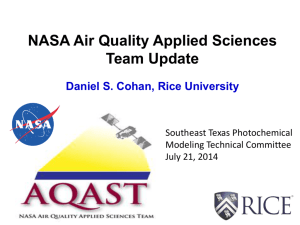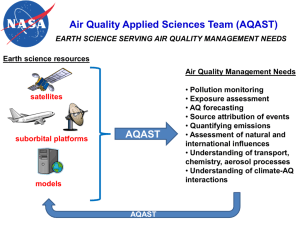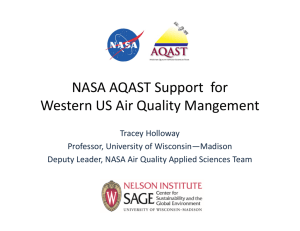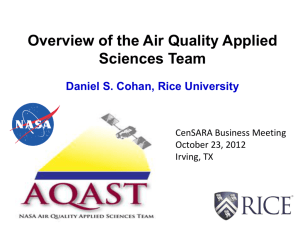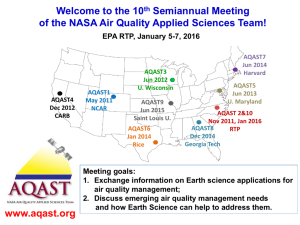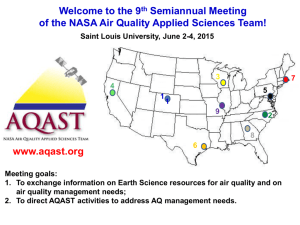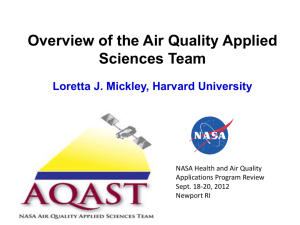NASA Air Quality Applied Sciences Team (AQAST)
advertisement
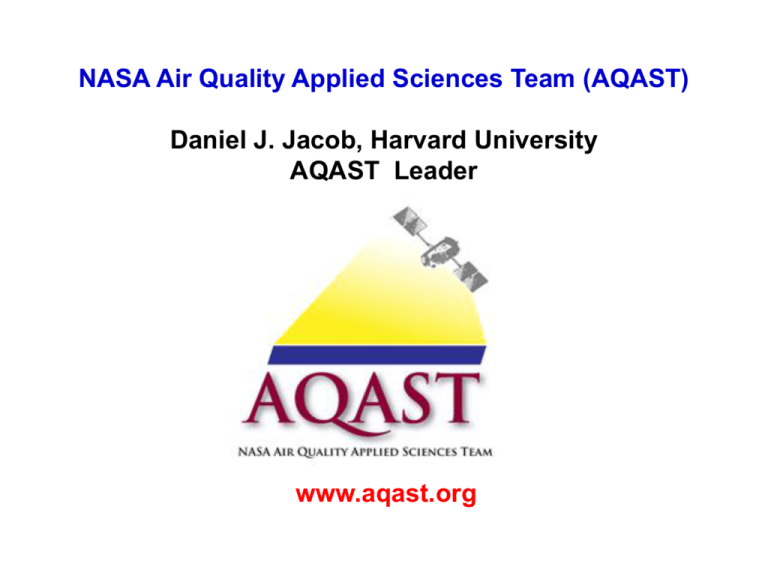
NASA Air Quality Applied Sciences Team (AQAST) Daniel J. Jacob, Harvard University AQAST Leader www.aqast.org satellites suborbital platforms AQAST models AQAST Pollution monitoring Exposure assessment AQ forecasting Source attribution Quantifying emissions Natural & foreign influences AQ processes Climate-AQ interactions AQAST members • Daniel Jacob (leader), Loretta Mickley (Harvard) • Tracey Holloway (deputy leader), Steve Ackerman (U. Wisconsin); Bart Sponseller (Wisconsin DNR) • Greg Carmichael (U. Iowa) • Dan Cohan (Rice U.) • Russ Dickerson (U. Maryland) • Bryan Duncan, Yasuko Yoshida, Melanie Follette-Cook (NASA/GSFC); Jennifer Olson (NASA/LaRC) • David Edwards (NCAR) • Arlene Fiore (Columbia Univ.); Meiyun Lin (Princeton) • Jack Fishman, Ben de Foy (Saint Louis U.) • Daven Henze, Jana Milford (U. Colorado) • Edward Hyer, Jeff Reid, Doug Westphal, Kim Richardson (NRL) • Pius Lee, Tianfeng Chai (NOAA/NESDIS) • Yang Liu, Matthew Strickland (Emory U.), Bin Yu (UC Berkeley) • Richard McNider, Arastoo Biazar (U. Alabama – Huntsville) • Brad Pierce (NOAA/NESDIS) • Ted Russell, Yongtao Hu, Talat Odman (Georgia Tech); Lorraine Remer (NASA/GSFC) • David Streets (Argonne) • Jim Szykman (EPA/ORD/NERL) • Anne Thompson, William Ryan, Suellen Haupt (Penn State U.) On AQAST website (google AQAST), click on “members” for list of 19 members and areas of expertise What makes AQAST unique? All AQAST projects connect Earth Science and air quality management: Involve active partnerships with air quality managers, have deliverable outcomes Expand relationships through meetings, online tools, newsletters AQAST has flexibility in how it allocates its resources Members adjust work plans to meet evolving air quality needs Multi-member “Tiger Teams” are organized each year to address newly emerging, pressing problems requiring coordinated activity AQAST is self-organizing and can respond quickly to demands Quick, collaborative, flexible, responsive to the needs of the AQ community www.aqast.org AQ agency Scope of current AQAST projects • Local: RAQC, BAAQD • State: TCEQ, MDE, Wisconsin DNR, CARB, Iowa DNR, GAEPD, GFC • Regional: LADCO, EPA Region 8 • National: EPA, NOAA, NPS Theme Satellites: MODIS, MISR, MOPITT, AIRS, OMI, TES, GOES, GOME-2 Suborbital: ARCTAS, DISCOVER-AQ, ozonesondes, PANDORA Models: MOZART, CAM, AM-3, GEOS-Chem, RAQMS, STEM, GISS, CMIP Earth Science resource Goals of this meeting • To share knowledge and experience in using Earth Science data and tools for serving AQ management • To educate AQ managers in the use of Earth Science data and tools, and to educate Earth scientists on AQ needs • To hear about pressing AQ management issues, and determine how AQAST can help – to-do list! AQAST4 at California Air Resources Board – December 2012 AQAST Highlight: CO trends and NOx budgets in Maryland MOPITT satellite instrument EPA site (Greenbelt) • Utility of satellites for longterm trend monitoring; • Regional character of NOx pollution; • NOx effective lifetime in models is too short. UMD aircraft during DISCOVER-AQ down wind Canty, Salawitch, Dickerson, et al. upwind from Baltimore CMAQ evaluation with OMI NO2 AQAST Highlight: OMI observes NOx decrease from implementation of emissions control devices (ECDs) on power plants: 2005-2011 B. Duncan, Y. Yoshida, L. Lamsal, B. de Foy, D. Streets, Z. Lu, N. Krotkov, and K. Pickering We analyzed the relationship between OMI NO2 columns and emissions from 55 power plants for 2005-2011. We found that OMI clearly detects the implementation of ECDs, though this relationship varies due to changes in the background levels of NO2 (e.g., from the decreasing mobile source), proximity to urban sources, magnitude of the emissions reduction, meteorology, etc. Crystal River facility, Florida ECDs implemented June 2009 OMI NO2 shows that regional levels decreased 2005 Crystal River Tampa 2011 x1015 molec/cm2 AQAST Highlight: Wyoming Exceptional Event Demonstration Wyoming DEQ/AQD used AQAST resources to issue an exceptional event demonstration package for an ozone exceedance at Thunder Basin, June 6, 2012 R.B. Pierce et al. AQAST Products • GLIMPSE (Henze): fast screening tool for radiative forcing implications of AQ management strategies • Operational AQ ensemble forecasts for Maryland (Thompson) • WHIPS (Holloway): user-friendly processing of satellite data AQAST progress toward an OMI AQ management toolkit: AQ managers can now… 1. Easily obtain useful data in familiar formats Custom OMI NO2 “Level 3” products on any grid in netCDF with WHIPS (Holloway) Annual NO2 shapefiles - OMI & CMAQ on CMAQ grids (AQAST Tiger Team) Google Earth 2. Find easy-to-use guidance & example scripts for understanding OMI products and comparing to simulated troposphere & PBL concentrations One-stop user portal (Holloway & AQAST Tiger Team) OMI NO2 & SO2 guidance, field campaign example case studies (Spak & AQAST Tiger Team) 3. Obtain OMI observational operators for assimilation & emissions inversion in CMAQ •NO2 in GEOS-Chem CMAQ (Henze, Pye) •SO2 in STEM CMAQ (Spak, Kim) •O3 in STEM CMAQ (Huang, Carmichael, Kim) AQAST PIs: Carmichael, Spak OMI NO2 KML in SARP flight planning AQAST communications and outreach NO2 trends lenticular • Twice-yearly AQAST meetings • AQAST workshops and training sessions • AQAST representation at AQ meetings • Ozone garden network • 2012 AGU AQAST session and Town Hall • Website, quarterly newsletter • Media center, Twitter ARSET/AQAST at CMAS St. Louis ozone garden

